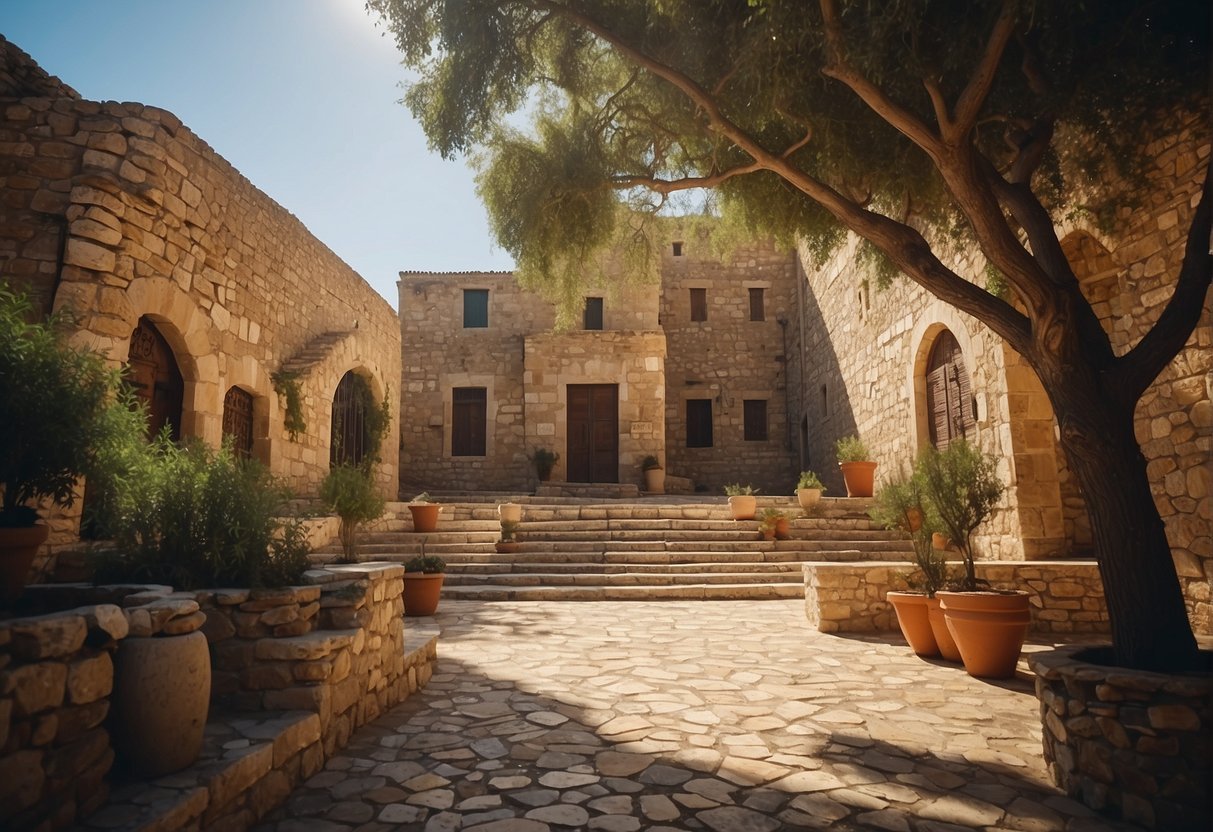crete breakfast – A Guide to the Island’s Timeless Wonders
Delicious Crete Breakfast: Traditional Dishes to Try
Imagine starting your day in Crete, the largest island in Greece. As the sun rises, you’re greeted with the enticing aroma of a traditional Crete breakfast.

This isn’t just a meal, it’s a cultural experience. A celebration of local ingredients and Mediterranean cuisine. From the savory Cretan omelet to the sweet kalitsounia pastries, each dish tells a story.
But where can you find the best breakfast in Crete? Is it in the bustling markets, the cozy restaurants, or perhaps in the comfort of your own kitchen with Crete breakfast recipes?
In this guide, we’ll explore the delicious world of Cretan breakfast. We’ll introduce you to traditional dishes, highlight the best spots to eat, and even share some recipes. So, whether you’re planning a trip to Crete or simply looking for breakfast ideas, get ready for a culinary journey like no other.
The Essence of a Cretan Morning
A Cretan morning starts with vibrant sights and sounds. Picture the serene landscape, dotted with olive groves and sea views. This breathtaking environment complements the rich flavors of a Cretan breakfast.

Central to this experience are the local ingredients, fresh from the markets. Crete prides itself on its use of olive oil, honey, and cheeses, which are staples of a “traditional Cretan breakfast”. These ingredients not only add flavor but embody the island’s commitment to fresh, unprocessed foods.
Breakfast in Crete is more than just food; it’s a way of connecting with tradition and community. Meals are often shared with family, turning breakfast into a social event. This communal aspect is cherished, reflecting the warmth of Cretan hospitality.
The philosophy of a healthy breakfast, rich in nutrients and taste, is deeply embedded in Cretan culture. The Cretan diet, part of the broader Mediterranean cuisine, is renowned for its health benefits, promoting longevity and vitality.
Embracing a Cretan morning means savoring each moment. The slow, unhurried pace encourages mindfulness, allowing you to fully enjoy the flavors and textures of every dish. In Crete, breakfast is not just about starting the day, but about celebrating life itself.
Cretan Breakfast Items: A Taste of Tradition
Cretan breakfast items offer an array of flavors and textures. These dishes often bring together sweet, savory, and tangy notes. They perfectly reflect the diversity of Cretan cuisine and its Mediterranean roots.
The island’s culinary heritage is evident in every bite. Recipes are passed down through generations, preserving a piece of Crete’s history. Locals take pride in using time-honored methods and fresh ingredients.
Let’s explore some Cretan breakfast classics. Each dish has its own unique charm and story:
- Dakos: A rusk-based dish that’s both crunchy and juicy.
- Bougatsa: A versatile pastry filled with sweet custard or savory cheese.
- Kalitsounia: Delicate cheese pastries, often enjoyed with honey.
- Cretan Omelet: Loaded with seasonal veggies and local cheese.
- Traditional Yogurt and Honey: A creamy and naturally sweet delight.

A visit to Crete isn’t complete without sampling these delights. Each item not only tantalizes the taste buds but also tells a story of the island’s culture.
These dishes make excellent breakfast ideas for those wanting a touch of Greece at home. Simple yet rich in flavor, they highlight the best of Cretan ingredients.
Bakeries across Crete are filled with the aromas of fresh pastries each morning. Locals and tourists alike flock to these spots to start their day with traditional treats.
Breakfast in Crete celebrates the synergy between land and sea. Ingredients are sourced locally, making them fresh and sustainable. This farm-to-table approach is at the heart of Cretan cooking.
These breakfast items embody the essence of Crete. They foster a connection to the island’s environment and its people. Enjoying them means embracing the warmth and soul of Cretan life.
Dakos: The Cretan Bruschetta
Dakos is a simple yet exquisite dish. It starts with a barley rusk, known for its hearty crunch. The rusk is doused with olive oil, soaking in the flavors.

On top of the rusk sits a blend of juicy tomatoes and crumbled feta. Oregano and olives often add depth to this Mediterranean favorite. It’s a perfect example of how Cretan cuisine marries basic ingredients for powerful taste.
Dakos captures the essence of Cretan food. It’s humble, yet bursting with the freshness of local produce. This dish is a must-try for anyone exploring the traditional flavors of Crete.
Bougatsa: Sweet or Savory Delight
Bougatsa offers a delightful duality. This pastry comes wrapped in delicate phyllo dough. Inside, you might find sweet custard or savory cheese.

The sweet version is dusted with cinnamon and sugar. Each bite is creamy, flaky, and subtly sweet. Conversely, the savory type boasts rich cheese flavors, making it a hearty breakfast item.
Bougatsa stands as a versatile breakfast staple. Whether sweet or savory, it represents the creative simplicity of Cretan cuisine. It’s a testimony to Crete’s ability to balance flavors in its traditional food.
Kalitsounia: Cheese Pastries with a Twist
Kalitsounia are small cheese pastries that bring a twist to breakfast. They are crafted with love and precision. The pastry’s delicate layers encase a filling of sweet myzithra cheese.

Traditionally, these pastries pair with honey, adding a delightful sweetness. You can also find a savory version, highlighting the cheese’s tangy notes. Both variations are a delightful way to begin your day.
Kalitsounia embodies Cretan creativity. They reflect the resourcefulness in utilizing local ingredients. A blend of flavor and craft, these pastries remind us of the joy in simple, traditional food.
Healthy Breakfast the Mediterranean Way
A Mediterranean breakfast embraces health and freshness. It features ingredients like fruits, nuts, and whole grains. This approach ensures a nutritious start to the day.
Cretan breakfast dishes are an integral part of this lifestyle. They incorporate fresh, local produce that bursts with flavor. For example, many meals include juicy tomatoes and crisp cucumbers.
Olive oil is another staple in Cretan cuisine. Its rich flavor and healthy fats are a perfect match for morning dishes. Drizzled over bread or used in cooking, it elevates any meal.

Eating the Cretan way means indulging in simple pleasures. With each bite, there’s a connection to the island’s natural bounty. This philosophy balances nutrition and enjoyment.
Choosing Cretan breakfast items is about more than taste. It’s a celebration of eating well while respecting the land. This tradition encourages savoring food mindfully.
The Role of Honey and Yogurt
Honey and yogurt are breakfast essentials in Crete. Cretan honey offers a unique sweetness, rich in natural flavors. Sourced locally, it often drizzles over creamy yogurt.

Yogurt itself is smooth and rich, a staple in many Cretan breakfasts. It’s frequently paired with fruits and nuts for added texture and nutrition. This combination creates a balanced, satisfying meal.
Together, honey and yogurt encapsulate the Mediterranean diet. They provide a healthy, delicious start to any day. Their simplicity and purity are unmatched.
Cretan Omelet: A Veggie-Packed Start
A Cretan omelet is a vibrant way to begin the morning. It combines fresh vegetables, enhancing their natural flavors. Each omelet tells the story of its ingredients.

Mizithra cheese is often added, giving creaminess and depth. This local cheese elevates the dish, making it distinctly Cretan. It complements the vegetables without overpowering them.
Packed with nutrients, a Cretan omelet is healthy and satisfying. It’s a reflection of seasonal ingredients and culinary tradition. Enjoying it offers a glimpse into Crete’s rich breakfast heritage.
From Markets to Tables: Where to Find the Best Breakfast in Crete
Crete is a paradise for breakfast enthusiasts. The island offers countless ways to enjoy a traditional Cretan breakfast. Both markets and eateries serve as gateways to local culinary delights.
Strolling through bustling markets is an experience in itself. Here, the aromas of fresh produce and baked goods fill the air. These markets present an opportunity to taste authentic Cretan breakfast items.
For those preferring a sit-down meal, Crete’s cafes and restaurants are perfect. They offer cozy settings where one can savor a leisurely breakfast. The island’s hospitality shines through in every dish served.

Each breakfast spot has its unique charm and specialties. From family-run bakeries to chic cafes, there’s something for everyone. Exploring these venues allows visitors to discover Crete’s diverse breakfast culture.
Whichever option you choose, breakfast in Crete is unforgettable. The emphasis on fresh ingredients and tradition enriches the experience. It’s a celebration of Cretan culture, one meal at a time.
Local Markets: A Feast for the Senses
Local markets in Crete are lively and vibrant. They are places where tradition meets daily life, especially in the morning. Every corner is filled with the promise of deliciousness.

Vendors offer everything from fresh fruits to handmade pastries. These markets are perfect for sampling Cretan breakfast items. Visitors can try bits and bites right on the spot.
Exploring a market is about discovery and connection. It’s a direct way to engage with Cretan culture through food. Here, breakfast becomes a sensory and social experience.
Restaurants and Cafes: Cretan Hospitality at Its Best
Cretan restaurants and cafes welcome guests with open arms. They are ideal settings for a relaxing breakfast experience. Each venue exudes warmth, complemented by delicious cuisine.

Breakfast menus often feature both traditional and modern dishes. Guests can indulge in classics or adventurous new options. Regardless of choice, quality and flavor remain consistent.
Dining at these establishments highlights Cretan hospitality. Staff are often eager to share stories and recommendations. This personal touch enhances every meal, making it memorable.
Crete Breakfast Recipes: Bring the Mediterranean Home
Recreating a traditional Cretan breakfast at home can be a delightful experience. Using authentic ingredients makes a huge difference. Olive oil, honey, and fresh herbs are essential.
Start with a Cretan omelet, a staple in many kitchens. This dish is both nutritious and flavorful. Local vegetables and mizithra cheese add a distinct Cretan touch.

For something sweet, consider making kalitsounia. These cheese pastries are loved for their balance of flavors. They’re perfect as a tasty morning treat.
Another easy recipe to try is dakos. This rusk with tomatoes and feta is refreshing and simple. It exemplifies the best of Mediterranean cuisine.
Experimenting with these recipes at home can be gratifying. It allows you to enjoy a taste of Crete wherever you are. Embrace the Cretan way of cooking and savor the flavors.
Embracing the Cretan Way of Life
A Cretan breakfast is more than just food; it’s a cultural embrace. This morning ritual reflects the island’s vibrant food heritage. It invites you to slow down and savor life.
From rustic dakos to the sweet bliss of bougatsa, each dish tells a story. It connects you with Crete’s rich traditions and warm hospitality. The simple, fresh ingredients keep you grounded and inspired.
Des ruines de la plus ancienne ville d'Europe aux vestiges de l'architecture vénitienne et ottomane, l'île est un musée vivant qui offre un aperçu des millénaires de réalisations humaines.
Pour les passionnés d'histoire, les trésors archéologiques de Crète offrent un voyage chronologique à travers l'ère minoenne jusqu'aux périodes historiques ultérieures. Chaque site constitue une fenêtre unique sur la vie des anciens habitants de l'île, invitant les visiteurs à explorer la grandeur des complexes palatiaux, des anciennes colonies et des structures religieuses.
L'île plonge profondément dans les civilisations passées et l'exploration de l'histoire avec des paysages naturels à couper le souffle et la possibilité de planifier une visite alliant aventure et histoire.
Sites historiques Crète
- Les sites historiques de Crète offrent un aperçu de l'ancienne civilisation minoenne et des époques historiques ultérieures.
- Les musées de l'île sont des trésors d'objets d'art, fournissant un contexte supplémentaire à ses sites archéologiques.
- Une visite en Crète est idéale pour combiner des visites historiques avec la beauté naturelle de l'île et des activités de plein air.
Points forts historiques de la Crète
La Crète, la plus grande île de Grèce, offre un éventail impressionnant de sites historiques qui témoignent de son passé long et varié. Des ruines d'anciennes civilisations aux vestiges de la domination vénitienne et ottomane, chaque site offre un aperçu unique du riche patrimoine de l'île.
Les palais minoens
- Palais de Knossos : Souvent considérée comme la plus ancienne ville d'Europe, la Palais de Cnossos est un témoignage de la sophistication de la civilisation minoenne. Le complexe du palais est un labyrinthe de chambres royales, de grands escaliers et de réserves.
- Palais de Phaistos : Le Palais de Phaistos dans le sud de la Crète, offre des vues imprenables et une atmosphère moins restaurée et plus atmosphérique que Knossos.
- Palais du maître mais non moins intrigant, le Palais de Malia révèle un mélange d'édifices résidentiels, religieux et funéraires.
- Palais de Zakros : Situé sur la côte est, le Palais de Zakros est connue pour son importance commerciale stratégique à l’époque minoenne.
Sites religieux et archéologiques
- Gortyne : Le site archéologique de Gortyne est crucial pour comprendre le passé romain de la Crète, avec des tablettes de code juridique bien conservées qui mettent en lumière les pratiques juridiques anciennes.
- Aptéra : Les restes à Aptéra datent des périodes minoenne, hellénistique et romaine et offrent un aperçu du paysage crétois.
- Bâtiments architecturaux de Réthymnon et de La Canée : Ces villes abritent un éventail de structures historiques, notamment des mosquées, des fontaines et des maisons mêlant esthétique locale et vénitienne.
Constructions de l’époque vénitienne et ottomane
- Forteresse vénitienne de Réthymnon : Surplombant la ville, cette forteresse symbolise la présence vénitienne et constitue un point focal pour les visiteurs intéressés par les périodes historiques ultérieures.
- Vieille ville de La Canée : Ici, vous pourrez vous promener dans les ruelles avec des bâtiments reflétant divers styles architecturaux, des époques vénitienne à ottomane.
Des paragraphes courts, des listes à puces et des titres en gras ont été utilisés pour plus de clarté et de facilité de lecture sur les ordinateurs de bureau et les appareils mobiles.
Les plus grands musées de Crète

La Crète abrite certains des musées les plus importants au monde, mettant en valeur la grandeur de la civilisation minoenne. En vous promenant dans ces institutions, vous rencontrerez des objets anciens et vous émerveillerez devant des fresques bien conservées qui ont résisté à l'épreuve du temps.
Musée archéologique d'Héraklion
Le Musée archéologique d'Héraklion est l'un des plus impressionnants de Grèce, offrant un aperçu complet de la riche histoire de la Crète. Voici à quoi vous pouvez vous attendre :
- Collections: S'étendant du Néolithique à la période romaine.
- Points forts: Incluez l'emblématique « disque de Phaistos » et les fresques exquises du palais de Knossos.
- Expérience: Découvrez plus de 15 000 artefacts offrant un aperçu de la culture minoenne sophistiquée.
Musée archéologique de La Canée
Aventurez-vous dans le Musée archéologique de La Canée et plongez-vous dans le passé diversifié de l'île. Les principales caractéristiques du musée comprennent :
- Emplacement: Installé dans une ancienne église vénitienne, offrant une atmosphère historique.
- Expositions: Présentez des artefacts minoens provenant de fouilles locales et des artefacts de diverses périodes.
- Artefacts uniques: Cherchez l'impressionnante collection de pièces de monnaie et de poteries minoennes.
Promenez-vous dans ces musées pour vous connecter profondément au patrimoine antique de Crète, face aux vestiges d'une civilisation qui a prospéré il y a des milliers d'années. Souvenez-vous de votre visite en explorant d'authentiques répliques de bijoux minoens et d'autres souvenirs dans les boutiques du musée. Ne manquez pas l'occasion de plonger plus profondément au cœur de l'histoire crétoise pendant votre séjour.
Nature et aventure
Embarquez pour un voyage à la découverte des superbes paysages naturels et des aventures palpitantes de la Crète. Qu'il s'agisse de traverser des gorges escarpées ou d'explorer les profondeurs d'anciennes grottes, la beauté naturelle de la Crète offre une expérience de plein air sans précédent.
Gorges de Samarie
Gorges de Samarie vous attire par sa présence majestueuse. Considérée comme l'une des plus longues gorges d'Europe, elle offre une randonnée à couper le souffle à travers les merveilles naturelles de la Crète.
- Emplacement: Montagnes Blanches (Lefka Ori)
- Distance: randonnée de 16 km
- Points forts:
- Une flore et une faune uniques
- Les célèbres « Portes de Fer », le point le plus étroit des gorges
Grottes et cavernes
Plongez dans le mystérieux monde souterrain de Crète grottes et cavernes. Ces merveilles géologiques sont ornées de fascinantes stalactites et stalagmites.
- Grottes célèbres:
- Grotte de Diktéon: Également connu comme le lieu de naissance de Zeus
- Grotte d'Idéon: Un site archéologique important
- Conseils aux visiteurs:
- Assurez-vous de porter des chaussures confortables
- La caméra est un incontournable pour les formations captivantes
Planifier votre visite
Lorsque vous planifiez votre visite des sites historiques de Crète, il est important de réfléchir aux modalités de voyage et à l'endroit où séjourner sur l'île. Assurez-vous de disposer d'informations touristiques à jour pour guider votre voyage et enrichir votre expérience.
Voyage et hébergement
- Voyage: La Crète est accessible par voie aérienne et maritime. Des vols quotidiens d'Athènes à Héraklion ou à La Canée et des ferries du Pirée à Héraklion, La Canée, Réthymnon et Agios Nikolaos sont disponibles.
- Voyage en avion: Vérifiez les horaires des vols à l'avance pour bénéficier des meilleures offres.
- Voyage en mer: UN voyage en bateau peut être un ajout pittoresque et agréable à votre itinéraire.
- Hébergement: Des resorts de luxe aux hôtels économiques, la Crète offre une variété d'options.
- Parcourir les hôtels : Utilisez des sites Web avec Données TripAdvisor pour comparer les notes et les avis.
- Réservez tôt: Surtout pendant les hautes saisons touristiques, pour garantir la disponibilité.
Informations touristiques et guides
- Informations touristiques: Visitez les offices de tourisme locaux pour obtenir des cartes et des brochures sur points d'intérêt et monuments.
- Sites culturels: Donnez la priorité à vos visites aux favoris des voyageurs comme le palais de Knossos.
- Événements et activités: Consultez les listes locales des événements culturels et des festivités pendant votre séjour.
- Guides: Embaucher un expert guide touristique peut améliorer votre expérience.
- Guides professionnels: Recherchez des professionnels agréés avec des avis positifs pour un aperçu historique.
- Visites autoguidées: Utilisez des applications mobiles et des guides si vous préférez une visite à votre rythme.
Pensez à réserver vos voyages et séjours à l'avance, recherchez auprès de sources fiables et pensez à enrichir votre visite avec des visites guidées. Votre exploration des sites historiques de Crète sera sûrement une aventure mémorable.






